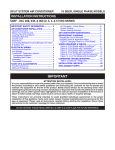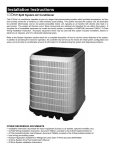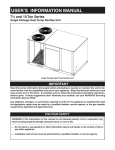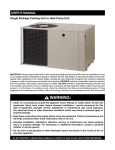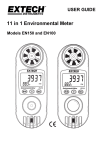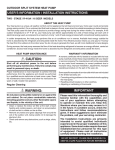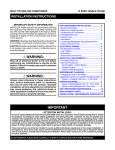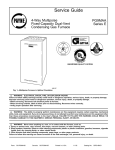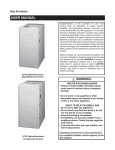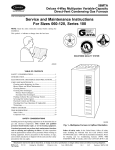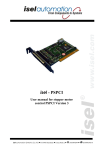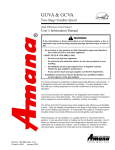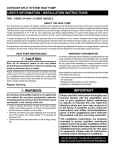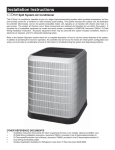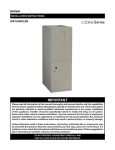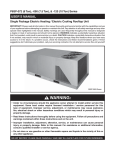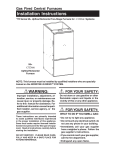Download 708882-A R6GP Series User manual.indd
Transcript
USER’S MANUAL R6GP Series Units Single Package Gas Heating /Electric Cooling Rooftop Unit R6GP-090 Shown IMPORTANT Read this owner information thoroughly and become familiar with the capabilities and use of your appliance before attempting to operate or maintain this unit. Keep this literature where you have easy access to it in the future. If a problem occurs, check the instructions and follow recommendations given. If these suggestions don’t eliminate your problem, call your NORDYNE Servicing Contractor (Service PRO). Any additions, changes, or conversions required for the appliance to satisfactorily meet the application needs must be made by a qualified installer, service agency, or the gas supplier using factory specified and approved parts. ! WARNING: FIRE OR EXPLOSION HAZARD • Failure to follow safety warnings exactly could result in serious injury or property damage. • Installation and service must be performed by a qualified installer, service agency or the gas supplier. • Do not store or use gasoline or other flammable vapors and liquids in the vicinity of this or any other appliance. WHAT TO DO IF YOU SMELL GAS • Do not try to light any appliance. • Do not touch any electrical switch; do not use any phone in your building. • Leave the building immediately. • Immediately call your gas supplier from a neighbors phone. Follow the gas suppliers instructions. • If you cannot reach your gas supplier, call the fire department. DO NOT DESTROY. PLEASE READ CAREFULLY AND KEEP IN A SAFE PLACE FOR FUTURE REFERENCE. 2 GENERAL INFORMATION This gas heating/electric cooling unit has been designed and built to provide many years of safe and dependable comfort, providing it is properly installed and maintained. With regular maintenance, this unit will operate satisfactorily year after year. Abuse, improper use, and/or improper maintenance can shorten the life of the appliance and create unsafe hazards. Please read this manual carefully to familiarize yourself with operation, maintenance, and safety procedures for this unit. To achieve optimum performance and minimize equipment failure, it is recommended that periodic maintenance be performed on this unit. The ability to properly perform maintenance on this equipment requires certain mechanical skills and tools. Please consult your dealer for maintenance information and availability of maintenance contracts WARNING: To avoid possible equipment damage, fire, or death, the following instructions must be observed regarding unit location, combustion air requirements, and operational procedures. Gas Heating/Electric Cooling Unit Location The area around the gas heating/electric cooling unit and the vicinity of any other gas appliances must be kept clear and free of combustible materials, gasoline, and other flammable vapors and liquids. Do not store or use flammable items such as paint, varnish, or strippers in the vicinity of the unit. Do not use the area around the unit as a storage area. This area must be kept clean and clear of loose or exposed insulation materials. Examine the unit’s area when it is installed or when insulation is added, since some insulation materials may be combustible. Do not use this appliance if any part has been under water. Immediately call a qualified service technician to inspect the unit and to replace any part of the control system and any gas control which has been under water. Familiarize yourself with the controls that shut off the gas and electrical power to the unit. If the unit is to be shut down for an extended period of time, turn off both the gas and electrical power. For your safety always turn off both the gas and electrical power before performing service or maintenance on the furnace. If the unit is operated with inadequate combustion air supply, the flame roll-out control switch located above the burners will open, turning off the gas supply to the burners. The flame roll-out control is a manual-reset device. DO NOT install a jumper wire across this switch to defeat its function. DO NOT reset the control without identifying and correcting the fault condition which caused the control to trip. If this switch must be replaced, use only the factory specified replacement part. WARNING: Combustion air must not be drawn from a corrosive atmosphere. To maximize heat exchanger life, the combustion air must be free of chemicals which form corrosive acidic compounds in the combustion gases. IMPORTANT NOTE: Do not place any chemicals with flammable or caustic vapors near the vent termination. Some examples of these chemicals are: • Gasoline/Kerosene • Permanent wave solutions • Chlorinated waxes and cleaners • Chlorine based swimming pool chemicals • Water softening chemicals • De-icing salts or chemicals • Carbon tetrachloride • Halogen type refrigerants • Cleaning solvents • Cements, glues, paint removers, varnishes, etc. • Hydrochloric acid • Masonry acid washing materials • Plumbing Stack Ductwork WARNING: Failure to prevent products of combustion from being circulated into the occupied space can create potentially hazardous conditions including carbon monoxide poisoning that could result in personal injury or death. The duct connections must be physically sound and sealed to the unit’s casing to prevent products of combustion from entering the occupied space. Combustion Air Supply The gas heating/electric cooling unit needs an adequate supply of combustion and ventilation air for proper and safe operation. Do not block or obstruct air openings on the unit or air openings supplying the area where it is installed. The return air and circulating air ductwork must not be connected to any other heat producing device such as a fireplace insert, stove, etc. Doing so may result in fire, explosion, personal injury, carbon monoxide poisoning, or property damage. 3 OPERATING INSTRUCTIONS Cooling Operation (1 or 2-Stage Operation) 1. Set the thermostat system switch to COOL and the thermostat fan switch to AUTO. (See Figure 1) 2. Set the thermostat temperature selector to the desired temperature level.The outdoor fans, compressors, and indoor blower will all cycle on and off to maintain the indoor temperature at the desired cooling level. Heating Operation (2 Stage) 1. Set the thermostat system switch to HEAT and the thermostat fan switch to AUTO. (See Figure 1) 2. Set the thermostat temperature selector to the desired temperature level. The indoor blower and gas heat module will cycle on and off to maintain the indoor temperature at the desired heating level. NOTE: On some units there is a factory set 3 minute time delay between Stage 1 and Stage 2 heat when Stage 2 heating is required. See Unit wiring diagram label. WARNING: If overheating occurs, or the gas supply fails to shut off, shut off the gas valve to the unit before shutting off the electrical supply. NOTE: This unit is equipped with a manual-reset flame roll-out limit switch.This switch acts to verify that the burner flame is being drawn into the heat exchanger tubes. If the flame is not being drawn into the tubes, the flame roll-out switch will open within several seconds. When this switch opens, the gas valve will de-energize to stop the flow of gas. The combustion inducer will stay energized and continue to operate until the thermostat is satisfied or the switch is closed. Do not reset the flame roll-out switch before identifying and correcting the fault condition that caused the switch to open. If the switch will not reset or continues to open, immediately contact a qualified serviceman to identify and repair the problem. System Shutdown Set the thermostat system switch to OFF and the thermostat fan switch to AUTO. (See Figure 1) NOTE: The system will not operate, regardless of the thermostat temperature selector’s setting. Operating the Indoor Blower Continuously Set the thermostat fan switch to ON (or CONT on some thermostat models). See Figure 1. The indoor blower will start immediately, and will run continually until the fan switch is reset to AUTO. 4 Figure 1. Typical Thermostat The continuous indoor blower operation can be obtained with the thermostat system switch set in any position, including OFF. The continuous indoor blower operation is typically used to circulate the indoor air to equalize a temperature imbalance due to a solar load, cooking, or fireplace operation. SYSTEM MAINTENANCE CAUTION: Verify all electrical power to the unit is disconnected and the gas is shut off before performing the following recommended maintenance. Proper maintenance is most important to achieve the best performance from the appliance and should be performed by a qualified service technician at least once a year. Follow the maintenance schedule and the instructions below for years of safe, trouble free operation. • Do not place combustible materials on or against the cabinet. • Do not store gasoline or any other flammable vapors and liquids in the vicinity of the unit. • Annually inspect the physical support of the unit to ensure that it is physically sound without sagging, cracks, gaps, etc., around the base so as to provide a seal between the support and the base. • Annually inspect the return-air connection to ensure that it is physically sound and is still sealed to the casing of the unit. • Annually inspect the unit, ductwork, and vent system for signs of physical deterioration. • Always replace the doors on the unit after servicing. Do not operate the unit without all doors and covers in place. CAUTION: DO NOT come in contact with any of the internal electrical components while cleaning the unit. Regular Cleaning: • Remove any debris from the outdoor coil. NOTE: Be careful not to damage the aluminum fins. • Check for and remove any obstructions to condenser airflow. • Clean the blower compartment regularly during the heating and cooling seasons to remove any dust that may have accumulated in the compartment or on the blower and motor. Buildup of dust on the blower and motor can create excessive loads on the motor resulting in higher than normal operating temperatures and possible shortened service life. Air Filters: WARNING: The motors for the circulating air blower, outdoor fan, and combustion blower are pre-lubricated at the factory. No further oiling is required for the life of this product. CAUTION: Some components in the burner assembly are at high temperatures while the burners are operating. Use caution to avoid injury. Burner Maintenance: Check the burner flames at the start of every heating season. Set the thermostat above room temperature. With the louvered service panel in place, rotate the burner observation port to the open position and visually inspect the burner assembly to make sure that the flame is drawn directly into the center of the heat exchanger tube (Figure 3). NOTE: In a properly adjusted burner assembly the flame color should be blue, however, some light yellow streaks may occur on the outer portions of the flame. Never operate the unit without a filter in the return air system. Dust and lint in the return air can build up on the internal components, resulting in loss of efficiency, equipment damage, and possible fire risk. R6GP Series units are factory equipped with pleated 2 inch disposable filters. The filters should be checked periodically and replaced (or cleaned) when necessary with filters of the same dimensional size. Replace using disposable fi lters with a minimum airfl ow rating of 500 FPM or permanent filters only. IMPORTANT NOTES: • The filter rack is field adjustable to accommodate 1” permanent filters. DO NOT use 1” disposable filters in these units. • Always replace the filter access panels after changing or cleaning the filters. DO NOT operate unit without the filter access panels in place. • Filters must be ULC approved or equivalent for use in Canada. Motor Lubrication: WARNING: The blower motor used in this unit is prelubricated and sealed by the manufacturer. Lubrication of the motor in this unit is not required. Figure 3. Burner Inspection Before Calling A Technician: If the unit fails to operate in cooling, check the following: 1. The thermostat is operating properly. Refer to “Cooling Operation.” 2. The electrical power to the unit is turned on. 3. The filters are not dirty. If the unit fails to operate in heating, check the following: 1. The thermostat is operating properly. Refer to “Heating Operation.” 2. The electrical power to the unit is turned on. 3. The gas is turned on. 4. The filters are not dirty. 5 FOR YOUR SAFETY READ BEFORE OPERATING WARNING: If you do not follow these instructions exactly, a fire or explosion may result causing property damage, personal injury, or loss of life. POUR VOTRE SÉCURITÉ. À LIRE AVANT L’EMPLOI ATTENTION! L’inobservation de ces instructions peut entraîner un incendie ou une explosion pouvant causer des dammages à votre propriété à votre personne, ou la mort. A. This appliance does not have a pilot. It is equipped with an ignition device which automatically lights the burner. Do not try to light the burner by hand. B. BEFORE OPERATING smell all around the appliance area for gas. Be sure to smell next to the floor because some gas is heavier than air and will settle on the floor. WHAT TO DO IF YOU SMELL GAS • Do not try to light any appliance. • Do not touch any electrical switch; do not use any phone in your building. • Immediately call your gas supplier from a neighbor’s phone. Follow the gas supplier’s instructions. • If you cannot reach your gas supplier, call the fire department. C. Use only your hand to push in or turn the gas control knob. Never use tools. If the knob will not push in or move by hand, do not try to repair it, call a qualified service technician. Force or attempted repair may result in a fire or explosion. D. Do not use this appliance if any part has been under water. Immediately call a qualified service technician to inspect the appliance and to replace any part of the control system and any gas control which has been under water. A. Cet appareil ménager n’a pas de veilleuse. II est doté d’un système d’allumage automatique. Ne pas essayer d’allumer le brûleur manuellement. B. AVANT L’USAGE. Attention à une possible odeur de gaz surtout au niveau du plancher où les gaz les plus lourds ont la tendance de se concentrer. EN CAS D’ODEUR DE GAZ. • Ne mettre en marche aucun appareil électrique. • Ne toucher à aucun commutateur électrique, ne pas employer le téléphone. • Quitter le bâtiment immédiatement et avertir la compagnie du gaz en utili sant le téléphone d’un voisin. • A défaut de la compagnie du gaz, avertir le service des pompiers. C. Enfoncer ou faire tourner le robinet à gaz à la main seulement. Ne jamais utiliser d’outils. S’il n’est pas possible de faire tourner ou d’enfoncer le robinet à la main, ne pas essayer de le réparer. Faire appel à un spécialiste. Forcer ou tenter de réparer le robinet pourrait être à l’origine d’une explosion ou d’un incendie. D. II est déconseillé d’utiliser cet appareil en contact prolongé avec l’eau. Faire inspecter ou remplacer toute commande par un technicien qualifié si un des systèmes de contrôle du gaz s’est trouvé sous l’eau. OPERATING INSTRUCTIONS MODE D’EMPLOI 1. STOP! Read the safety information above on this label. 2. Set the thermostat to the lowest setting. 3. Turn off all electrical power to the appliance. 4. The appliance’s ignition device automatically lights the burner. Do not try to light burner by hand. 5. Remove the control access door/panel (upper door if two-door model). 6. Move the gas control knob clockwise to “OFF”. (See Figure 1) 7. Wait five (5) minutes to clear out any gas. Then smell for gas, including near the floor. If you smell gas, STOP! Follow “B” in above information. If you don’t KNOB smell gas, go to the next (ROBINET) step. 8. Move the gas control knob counterclockwise to “ON”. (See Figure 1) 9. Replace the control access door/panel (upper door if two-door model). 10. Turn on all electrical Figure 1 power to the appliance. 11. Turn the thermostat to a desired setting. 12. If the appliance will not operate, follow the instructions “To Turn Off Gas To Appliance” and call your service technician or gas supplier. TO TURN OFF GAS TO APPLIANCE 1. Set the thermostat to the lowest setting. 2. Turn off all electrical power to the appliance if service is to be performed. 3. Remove the control access door/panel (upper door if two-door model). 4. Move the gas control knob clockwise to “OFF”. Do not use force. (See Figure 1) 5. Replace the control access door/panel (upper door if two-door model). ¢7106757¤ 1. ATTENTION! Lire d’abord la liste des mesures de sécurité ci-dessus. 2. Mettre le thermostat à la position minimale. 3. Couper le courant électrique qui mène à l’appareil. 4. Cet appareil ménager étant doté d’un système d’allumage automatique, ne pas essayer d’allumer le brûleur manuellement. 5. Retirer le panneau/volet d’accès de commande (panneau supérieur s’il s’agit d’un modèle à deux panneaux). 6. Faire tourner le robinet à gaz dans le sens des aiguilles d’une montre pour l’amener sur la position OFF (Arrêt) (Voir Figure 1). 7. Attendre cinq (5) minutes pour s’assurer de la dissipation du gaz. En cas d’odeur, ARRÊTER LE PROCÉDÉ. Suivre les instructions ci-dessus (Section B). En l’absence de toute odeur de gaz, avancer à l’étape suivante. 8. Faire tourner le robinet à gaz dans le sens inverse des aiguilles d’une montre pour l’amener sur la position ON (Marche) (Voir Figure 1). 9. Remettre le panneau/volet d’accès de commande en place (panneau supérieur s’il s’agit d’un modèle à deux panneaux). 10. Rebrancher l’appareil sur le réseau électrique. 11. Ajuster le thermostat à la position désirée. 12. Si l’appareil ne fonctionne pas, suivre les “Directives d’arrêt” cidessous et appeler le technicien de service. DIRECTIVES D’ARRÊT 1. Mettre le thermostat à la position minimale. 2. Débrancher l’appareil en prévision de la réparation. 3. Retirer le panneau/volet d’accès de commande (panneau supérieur s’il s’agit d’un modèle à deux panneaux). 4. Faire tourner le robinet à gaz dans le sens des aiguilles d’une montre pour l’amener sur la position OFF (Arrêt) Ne pas forcer (Voir Figure 1). 5. Remettre le panneau/volet d’accès de commande en place (panneau supérieur s’il s’agit d’un modèle à deux panneaux). Gas Valve Label for 6 Ton Units 6 7106750 (Replaces 710329A) (03/07) FOR YOUR SAFETY READ BEFORE OPERATING WARNING: If you do not follow these instructions exactly, a fire or explosion may result causing property damage, personal injury, or loss of life. POUR VOTRE SÉCURITÉ. À LIRE AVANT L’EMPLOI ATTENTION! L’inobservation de ces instructions peut entraîner un incendie ou une explosion pouvant causer des dammages à votre propriété à votre personne, ou la mort. A. This appliance does not have a pilot. It is equipped with an ignition device which automatically lights the burner. Do not try to light the burner by hand. B. BEFORE OPERATING smell all around the appliance area for gas. Be sure to smell next to the floor because some gas is heavier than air and will settle on the floor. WHAT TO DO IF YOU SMELL GAS • Do not try to light any appliance. • Do not touch any electrical switch; do not use any phone in your building. • Immediately call your gas supplier from a neighbor’s phone. Follow the gas supplier’s instructions. • If you cannot reach your gas supplier, call the fire department. C. Use only your hand to push in or turn the gas control knob. Never use tools. If the knob will not push in or move by hand, do not try to repair it, call a qualified service technician. Force or attempted repair may result in a fire or explosion. D. Do not use this appliance if any part has been under water. Immediately call a qualified service technician to inspect the appliance and to replace any part of the control system and any gas control which has been under water. A. Cet appareil ménager n’a pas de veilleuse. II est doté d’un système d’allumage automatique. Ne pas essayer d’allumer le brûleur manuellement. B. AVANT L’USAGE. Attention à une possible odeur de gaz surtout au niveau du plancher où les gaz les plus lourds ont la tendance de se concentrer. EN CAS D’ODEUR DE GAZ. • Ne mettre en marche aucun appareil électrique. • Ne toucher à aucun commutateur électrique, ne pas employer le téléphone. • Quitter le bâtiment immédiatement et avertir la compagnie du gaz en utili sant le téléphone d’un voisin. • A défaut de la compagnie du gaz, avertir le service des pompiers. C. Enfoncer ou faire tourner le robinet à gaz à la main seulement. Ne jamais utiliser d’outils. S’il n’est pas possible de faire tourner ou d’enfoncer le robinet à la main, ne pas essayer de le réparer. Faire appel à un spécialiste. Forcer ou tenter de réparer le robinet pourrait être à l’origine d’une explosion ou d’un incendie. D. II est déconseillé d’utiliser cet appareil en contact prolongé avec l’eau. Faire inspecter ou remplacer toute commande par un technicien qualifié si un des systèmes de contrôle du gaz s’est trouvé sous l’eau. OPERATING INSTRUCTIONS MODE D’EMPLOI 1. STOP! Read the safety information above on this label. 1. ATTENTION! Lire d’abord la liste des mesures de sécurité ci-dessus. 2. Set the thermostat to the lowest setting. 2. Mettre le thermostat à la position minimale. 3. Turn off all electrical power to the appliance. 3. Couper le courant électrique qui mène à l’appareil. 4. The appliance’s ignition device automatically lights the 4. Cet appareil ménager étant doté d’un système burner. Do not try to light burner by hand. d’allumage automatique, ne pas essayer d’allumer le 5. Remove the control access door/panel (upper door if brûleur manuellement. two-door model). 6. Move the gas control switch to the “OFF” position. (See 5. Retirer le panneau/volet d’accès de commande (panneau supérieur s’il s’agit d’un modèle à deux Figure 1) panneaux). 7. Wait five (5) minutes to clear out any gas. Then 6. Réglez l’interrupteur de commande du gaz à la position smell for gas, including near the floor. If you “OFF”. (voir Figure 1). smell gas, STOP! Follow “B” in SWITCH 7. Attendre cinq (5) minutes pour s’assurer de la above information. If you (INTERRUPTEUR) dissipation du gaz. don’t smell gas, go to En cas d’odeur, ARRÊTER LE PROCÉDÉ. Suivre les the next step. instructions ci-dessus (Section B). En l’absence de 8. Move the gas control toute odeur de gaz, avancer à l’étape suivante. switch to the “ON” 8. Réglez l’interrupteur de commande du gaz à la position position. (See Figure 1) “ON”. (voir Figure 1). 9. Replace the control 9. Remettre le panneau/volet d’accès de commande en access door/panel place (panneau supérieur s’il s’agit d’un modèle à deux (upper door if two-door Figure 1 panneaux). model). 10. Rebrancher l’appareil sur le réseau électrique. 10. Turn on all electrical power to the appliance. 11. Ajuster le thermostat à la position désirée. 11. Turn the thermostat to a desired setting. 12. If the appliance will not operate, follow the instructions 12. Si l’appareil ne fonctionne pas, suivre les “Directives d’arrêt” cidessous et appeler le technicien de service. “To Turn Off Gas To Appliance” and call your service technician or gas supplier. TO TURN OFF GAS TO APPLIANCE DIRECTIVES D’ARRÊT 1. Set the thermostat to the lowest setting. 1. Mettre le thermostat à la position minimale. 2. Turn off all electrical power to the appliance if service is 2. Débrancher l’appareil en prévision de la réparation. to be performed. 3. Retirer le panneau/volet d’accès de commande 3. Remove the control access door/panel (upper door if (panneau supérieur s’il s’agit d’un modèle à deux two-door model). panneaux). 4. Move the gas control switch to the “OFF” position. Do 4. Réglez l’interrupteur de commande du gaz à la position not use force. (See Figure 1) “OFF”. Ne forcez pas. (voir Figure 1). 5. Replace the control access door/panel (upper door if 5. Remettre le panneau/volet d’accès de commande en two-door model). place (panneau supérieur s’il s’agit d’un modèle à deux panneaux). 710674-0 (Replaces 7104030) (03/07) Gas Valve Label for 7.5 and 10 Ton Units 7 ¢708882H¤ O’Fallon, MO 708882A
This document in other languages









